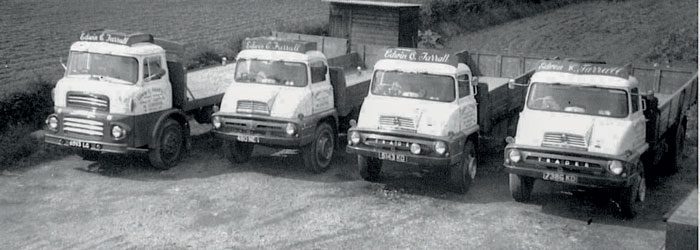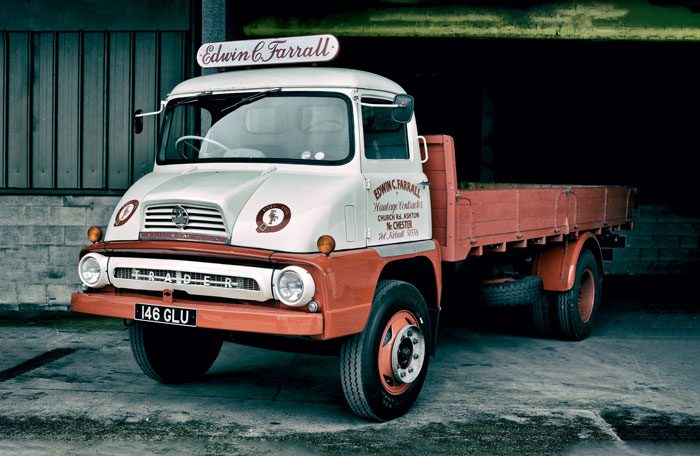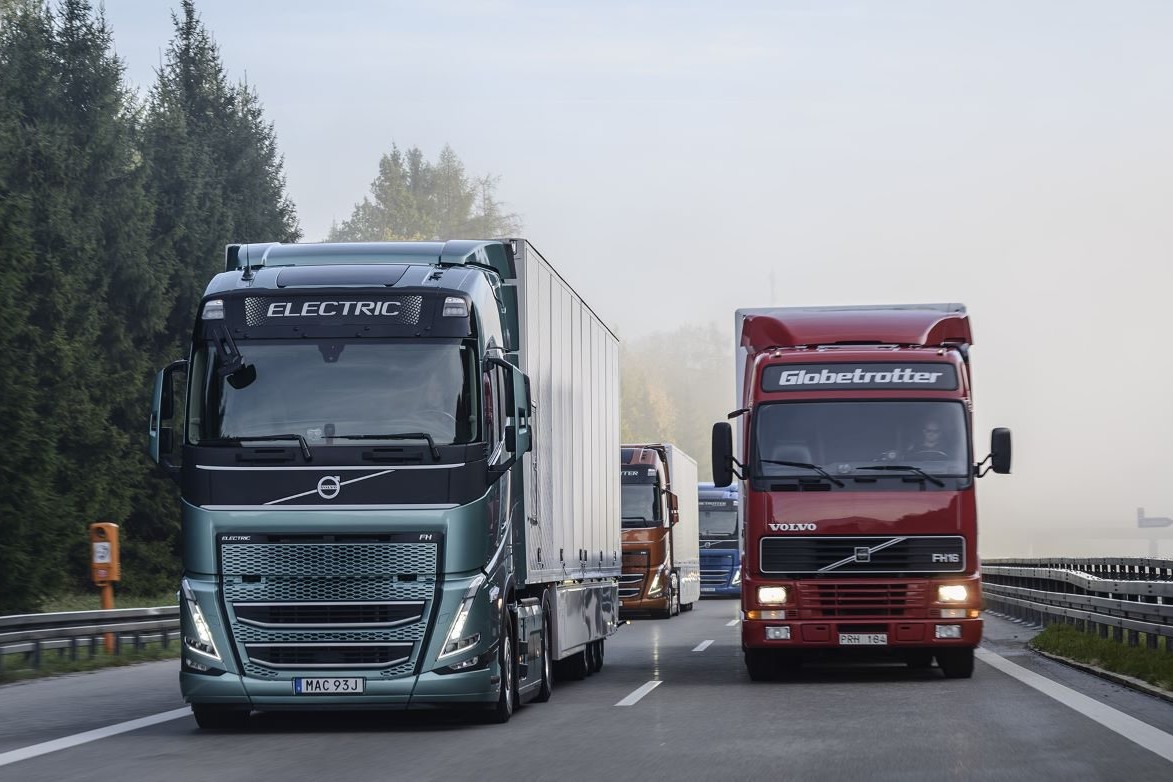DOING IT TOGETHER
Will Shiers meets up with a couple of British haulage pioneers, who have a fascinating story to tell.

Photo: Farrall‘s today.
That‘s how it all began,” says a proud 89-year-old Edwin (Eddie) Farrall, showing me a photograph of a boy driving a goat-drawn cart. “That was me at the age of nine, delivering sticks to houses. I made that cart. The shafts are chair legs and the mudguards are sides of a barrel. They published that picture in the Staffordshire Evening Sentinel, because I shouldn‘t have been on the road!” “And I still have a copy of the newspaper,” adds wife of 65 years Joan Farrall, who together with her husband created and built family-run firm Farrall‘s Transport (now Farrall‘s Group), based in Cheshire, in the northwest of England. “Notice that he‘s wearing a tie,” continues Joan. “That‘s right. I always wear a tie, because I think it‘s important to make a good impression,” adds Eddie. I‘m suddenly regretting turning up to the interview open collared, so quickly change the subject, and ask what Eddie would have done if he hadn‘t had a career in road haulage. “That‘s easy. I would have been a farmer,” he says without any hesitation, going on to explain that his father was a farmer when he was a teenager, and by the age of 15 he was working on eight farms.

Photo: Today the Farrall‘s operation is a far cry from its humble roots, but family values still underpin it.
The same applies to Joan, whose father was a farm labourer. “I‘d have definitely followed him into farming,” she says. “The fact that his father was a farmer was one of Eddie‘s good points,” she says, smiling. “That and he had a car!” But before Eddie‘s father was a farmer, he was a publican, and it‘s then that Eddie had his first encounter with lorries. He takes up the story: “My dad was a coal miner until 1933, and then he won some money. He took on a pub, which had a lodger who was a lorry driver. I used to ride around in that 3-ton Bedford cattle truck. It‘s what got me into transport. I didn‘t like school; I wasn‘t a listener and didn‘t want to be there. But what I did want to do was go in that truck, and read all the signs on the road and the names on the trucks. I learned to read quicker.” After a few years working on the land Eddie was behind the wheel of a truck, driving for a local farm haulier. The seeds were well and truly sown now, and he wanted to set up his own transport company. When he was in his early 20s, Eddie met someone who would help him achieve his dream – future wife Joan. But when he met her she was only 17, and despite the couple wanting to tie the knot immediately, Joan‘s father had other ideas. “In those days you asked the parents for the hand in marriage,” recalls Eddie. “And the first thing he [Joan‘s father] said was, ‘where are you going to live?‘ I told him we were thinking of buying a caravan. Well!”

Photo: Eddie and Joan with their Thames Trader.
“He said ‘bricks and mortar for my daughter‘,” says Joan. With no wedding to plan or caravan to buy, the couple put the £300 ($618) they had saved towards an operator‘s licence. In those days, the cost for one of these was £300 per unladen weight ton. And because Eddie and Joan wanted a 3-ton Bedford, they had to find £900 ($1845). An extra £110 ($226) was raised by selling Eddie‘s beloved SS Jaguar car (it would be many decades before he replaced it), and the rest was covered by hire purchase. The petrol-powered Bedford was thirsty, and capable of carrying no more than 6 tons, meaning it was difficult to make a decent wage. “It only did 10 to the gallon, and then there was the hire purchase to pay,” recalls Eddie. When Joan turned 21, the couple promptly married, moving into a caravan. “It was parked down a lane, and didn‘t have any running water or electricity,” remembers Joan, who by this stage was bookkeeping for the company. Still struggling to scrape a living with the Bedford, it was sold, and replaced by a Seddon. Running on diesel, and capable of carrying more weight, the truck immediately put the couple in a better financial situation, and the hire purchase was soon paid off.
 |
 |
 |
 |
Proudest moment “Buying my first new truck was my proudest moment,” remembers Eddie. “It had been a struggle up until then, but now we were on the way to success.” The truck in question was a Thames Trader, and he owns a fully restored one today. “I worked day and night in that Trader. Up to Scotland and all over the country, carrying Marley roof tiles. It was really hard work, and my wrists got cut to ribbons, but we made money,” says Eddie. “At this point he told me I could start drawing a wage out of the business,” says Joan. “It was £10 a week, and I felt like a millionaire. Although we were still living in a caravan!” The arrival of kids (they would eventually have five) meant the Farralls finally outgrew the caravan, and moved into a cottage on Eddie‘s father‘s farm. At this time the fleet was growing too, and by 1961 they had five Thames Traders, all doing Marley tile work. “It was hard graft, and we were blowing tyres on building sites,” says Eddie. “They said the tiles weighed 1 ton per 1000, but I knew they were heavier than that.” He‘d had enough! In a spur of the moment decision, Eddie quit the tile work, and instead started moving cardboard for a local firm. “It was forklifted on, and forklifted off, and there were nice smooth roads to the factory. It was utopia,” says Eddie, who reckons it taught him a valuable lesson. “From that point onwards I decided I never wanted to carry anything heavy again,” he says. “Next I went into a toilet paper factory and got that job.

Photo: The Farrall‘s fleet of Thames Traders back in the day.
People would say ‘you should get some work in the steelworks‘, and I‘d reply ‘no I bloody don‘t as it‘s too heavy‘.” Farrall‘s Transport boomed and over the coming years the couple purchased their own yard and house, and were soon running 20 trucks. Studying the numerous photos the couple brought for me to see, it‘s clear that Farrall‘s Transport has run a lot of different marques over the years. In addition to the Bedford, Seddon and Thames Traders already mentioned, I can see some Ford D-series, Atkinson Borderers and plenty of 1970s Mercedes-Benzes. But as far as Eddie is concerned, the greatest truck ever built is the current Volvo FH. “It‘s streets ahead of the rest of them,” he reckons. It‘s also the most prominent truck in today‘s 70-strong fleet. During their days at the helm of Farrall‘s Transport, Eddie and Joan built a very successful transport business. By their own admission, Eddie was a tough boss, but definitely fair. He also commanded a lot of respect amongst his drivers, many who counted him and Joan as friends. Farrall‘s Transport prides itself on the large number of long-serving drivers it has. One recently retired after 47 years with the firm, and another member of staff has been there for 37 years. Eddie believes the secret behind the haulier‘s ability to retain staff has a lot to do with the respect they get. The couple retired in 1995 when Eddie was 65, handing over the reins to sons Mark and Mike. But Eddie admits that in the early days of retirement he couldn‘t quite let go. “I remember we went on holiday once and when we came back Mike had put new electric garage doors on the workshops. Bloody hell, how much have they cost? And then they resurfaced the yard to motorway spec.

Photo: The first new truck Eddie and Joan bought was a Thames Trader, and they own a fully restored one today.
It cost £100,000 ($206,000), and I nearly had a heart attack!” “Eddie said to me ‘they‘re going to make mistakes‘,” says Joan. “I said ‘yes they will, but they will learn from them‘. I said ‘leave them to get on with it. If they want advice they will come and ask for it‘, and they did, and still do.” Eddie needn‘t have worried. Farrall‘s Group has grown steadily in the past 25 years, and now owns and operates a number of warehouses. These days Eddie and Joan are well and truly retired, happy in the knowledge that the company they founded is in the safe hands of younger generations of Farralls. Joan has passed on her bookkeeping skills to daughter-in-law Elaine, who in turn passed it on to her daughter Kat, and these days Eddie spends much of his spare time under the bonnet of his three beloved SS Jaguars. Now for the final question: “Would you do it all again?” I ask. It‘s a resounding ‘yes‘ from both of them. “We have enjoyed it all,” says Eddie. “There were some bad times, but we got through them.” “Yes, like laying awake at 3am, trying to decide whether to buy the next truck,” adds Joan. “We have done it together,” says Eddie, putting his arm around his wife, “me and my soul mate here!” “I‘m just his back-up, to catch him when he falls,” adds Joan, with a smile.

Photo: Eddie and Joan take Will down memory lane.
ASSET RICH
Eddie says one of the most important things to have when running a successful company would be assets, something he was sadly lacking in the early days of Farrall‘s Transport. “My sons are fortunate that they have collateral, but I never had that,” he says, before recounting a meeting with a bank manager during the early days of the company. “I went to see him because I needed an overdraft. He asked me what assets I had, and I told him I had a caravan, a car and a truck. He said ‘they all have wheels and could be gone tomorrow, so we can‘t lend you anything‘.”
FARRALL‘S GROUP TODAY
The growth that Farrall‘s Group has seen in recent years is beyond Eddie and Joan‘s wildest dreams. Both were incredibly proud when, in 2019, grandchildren Matthew and Kat took the reins as joint MDs. The aim of this third generation is to take the business forward while striving to remain at the forefront of the industry through technology. They tell me they “want to ensure that the ethos of a traditional family business and the longstanding culture and values our grandparents and parents built are retained”.

Read more
The Foden way
0 Comments7 Minutes
Red-tape resilience
0 Comments12 Minutes
Middle Eastern Magic
0 Comments1 Minute
30 years of innovation
0 Comments13 Minutes





